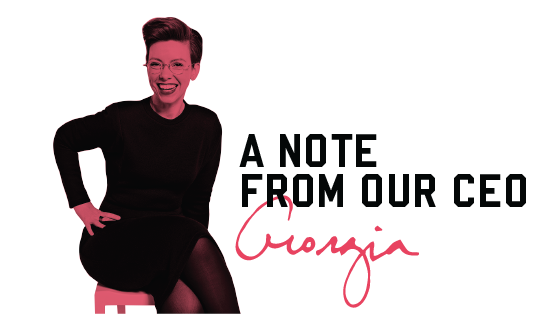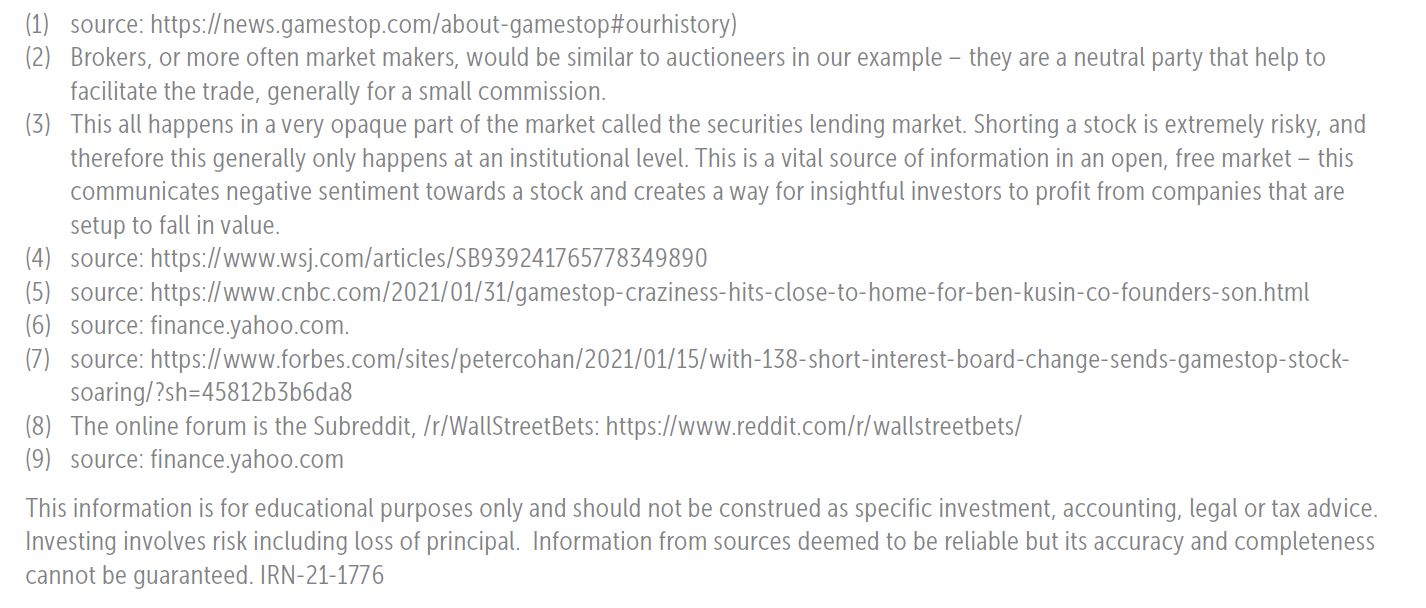February 2021: What actually happened with GameStop?
MODERNIST’S ASSET CLASS INVESTING PORTFOLIOS ARE STRATEGICALLY INVESTED WITH A FOCUS ON LONG-TERM PERFORMANCE OBJECTIVES. PORTFOLIO ALLOCATIONS AND INVESTMENTS ARE NOT ADJUSTED IN RESPONSE TO MARKET NEWS OR ECONOMIC EVENTS; HOWEVER, OUR INVESTMENT COMMITTEE EVALUATES AND REPORTS ON MARKET AND ECONOMIC CONDITIONS TO PROVIDE OUR INVESTORS WITH PERSPECTIVE AND TO PUT PORTFOLIO PERFORMANCE IN PROPER CONTEXT.
In 1984, 33-year-old Gary Kusin started an educational software retailer named Babbage’s. Founded in Dallas, Texas, Babbage’s quickly expanded from educational software to a focus on Atari and Nintendo video games. Little did Gary know at the time, but his company would one day become a symbol of a wild moment in recent stock market history, capture the attention of investors, Congress, and regulators across the United States.
But before we get into what Gary Kusin’s small company became, we need to understand a few key terms and mechanics of a stock market. (1)
Wait, what actually happens when stocks are bought or sold?
Stock markets are exchanges, and in their simplest form are simply open-market auctions. Think Sotheby’s or a local estate sale auction, where potential buyers raise their paddle until only one buyer remains - but at a much much larger scale. Thousands of buyers meet thousands of sellers every day through brokers on stock exchanges (2), while the items of interest are shares of a company’s stock.
Generally, none of the money in these transactions goes to the company; rather the two parties barter for existing shares of the stock. Most of this activity has now moved from a trading floor to the digital realm, but the fundamentals are the same: every transaction has a buyer and a seller, and presumably both sides think they are getting a good deal.
Shorting: How to Bet Against a company’s Stock
Occasionally an investor may see a stock that they believe is overvalued. They believe that buyers are willing to pay more for that stock than what it is actually worth. For those brave investors who want to take action on this belief, a process exists for them to bet against the company’s stock.
Through a broker, Investor #1 connects with Investor #2 who owns shares of the stock.
Investor #1 borrows (instead of buying) the shares from Investor #2.
Investor #1 then sells them to yet another investor, Investor #3.
Assuming the price of the stock declines, Investor #1 can buy back the shares at a lower price, and then return them to Investor #2, thereby making a profit by pocketing the difference in price.
This is ideally how “shorting a stock” works. (3)
Margin Calls: When the Bet goes bad
However, just as a bank may monitor a borrower’s credit worthiness, the lender of the shares needs protection to ensure that the borrower will eventually be able to repay the loan. The broker of that original deal monitors how much it would cost for the borrower to purchase the shares outright (not just borrow them) compared to how much money the investor has available in their account.
If the price of the stock rises too much, the broker can demand the investor either deposit more cash in their account or return the shares.
If Investor #1 is forced to return the shares, they must go back out to the market, and hope to find yet another investor willing to sell so that they can repurchase them.
Known as a “margin call” in financial jargon, this requirement protects the lender from Investor #1 taking on a loan they can’t repay.
what does all this have to do with an 80’s software retailer?
In 1999, fifteen years after being founded, Barnes & Noble purchased Babbage’s for nearly $200 million. (4) Three years later, Babbage’s was combined with other similar retailers, and the company went public under a new name, GameStop. (5)
Now, nearly 20 years after going public, GameStop became a stock market phenomenon when the stock price jumped from $18.84 on December 31, 2020 to $325 at the end of January, a 1,625% jump in a single month. (6)
For those listening to financial media (or social media for that matter), the obvious question is how on earth did this happen?
Well, a lot of investors were betting against GameStop at the end of last year – a lot. In fact, every share of GameStop had been borrowed and sold, at least once. (7) In January, more investors started to take interest in buying shares of GameStop, partially spurred by speculative investors in an online forum (8), and that demand pushed the price of GameStop higher.
As the price continued to climb, the investors who had borrowed shares were forced to either put more money into their account or buy shares at a higher price to close their loan. As the price of GameStop’s stock climbed, more investors bought shares to cover their loans, which created more demand for shares of GameStop’s stock, which continued to push the price higher.
This phenomenon is called a short squeeze; the cycle continued throughout January, when the stock hit a high of $483 on January 28. (9)
What does this all mean for your portfolio?
Thankfully, if you’re a Modernist client, not a lot. Our clients own thousands of stocks in an effort to mitigate the risk of any short-term price dysfunction of any single security in the markets.
Investors who bet against GameStop were wrong, at least for now, and they had to buy a lot of GameStop stock to make up for their error.
If margin calls didn’t exist, January may have looked very different for the price of GameStop’s stock. But, margin calls do exist to protect lenders and they functioned as expected. Thousands of buyers met thousands of sellers, and they agreed to exchange shares of a stock for an agreed upon price.
Tuning out the financial noise
On any given day, the stock market can look like a casino with too much excitement and too many random outcomes. But, when viewed over longer time horizons, the outcomes are logical.
This is why we encourage our clients to tune out the daily financial noise – no matter how entertaining – and to keep a long-term focus.
Meanwhile, if you have questions about your investments, charitable giving strategy, or are looking for a partner to help you make progress towards your financial goals, reach out. We’re ready and happy to help.
Cheers,
Georgia & Team Modernist
p.s. And, just in case you’re wondering, we don’t think it’s a good time to buy GameStop stock!


